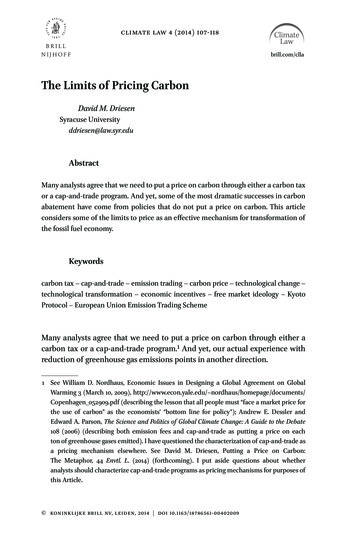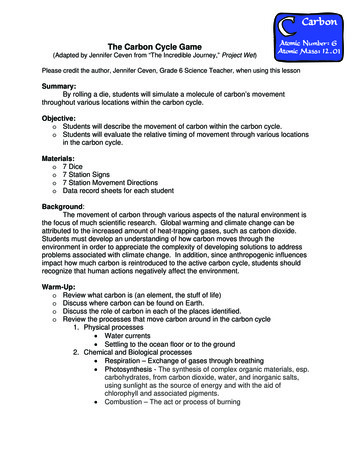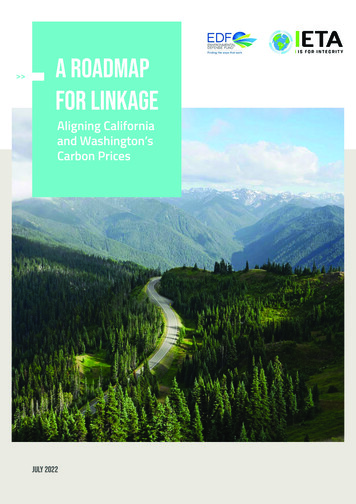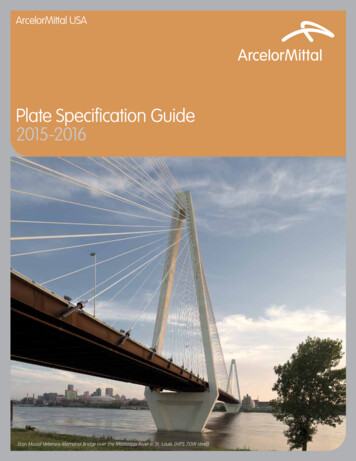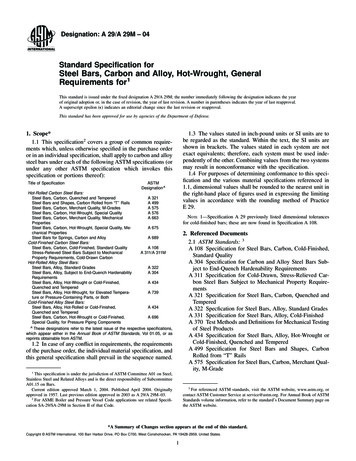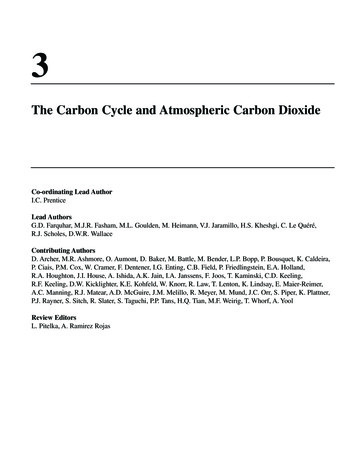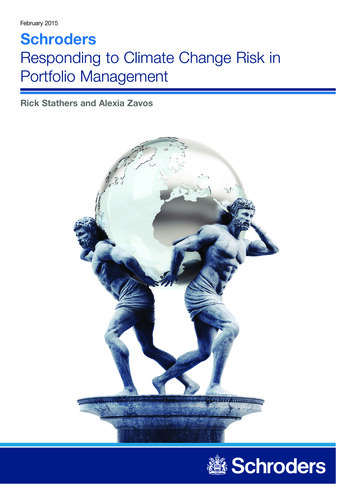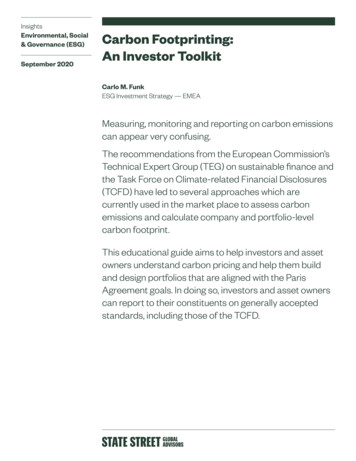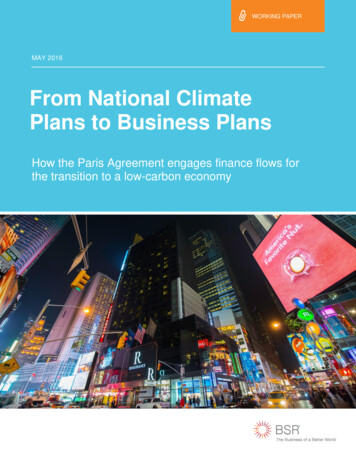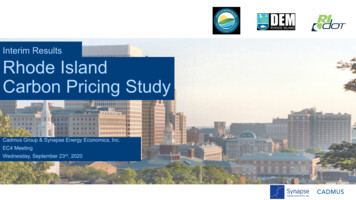
Transcription
Interim ResultsRhode IslandCarbon Pricing StudyCadmus Group & Synapse Energy Economics, Inc.EC4 MeetingWednesday, September 23rd, 2020
Agenda Welcome, Background & Introductions Overview of Carbon Pricing Scenarios Initial Modeling Results Initial Policy Analysis and Stakeholder Engagement Findings Questions and Feedback2
Background &Introductions3
Project OverviewThe purpose of this study is to provide an impartial assessment of potential state and regional carbon pricingpolicies. It is intended to inform (not set) policy design.As context, the Resilient Rhode Island Act of 2014 created greenhouse gas (GHG) emissions reductionstargets for at 45% below 1990 levels by 2035 and 80% below 1990 levels by 2050.Final DeliverablesA report and associatedpresentation that outline keyfindings from the policyanalysis, modeling andstakeholder engagement.Note that this study isconducted in the context ofother related efforts in the State.4Leading AgenciesConsulting Support From
Project StatusTasks5StatusTask 1. Project ManagementOngoingTask 2. Literature Review andPolicy SelectionCompleteTask 3. Policy AnalysisIn ProgressTask 4. Carbon Pricing andEconomic ModelingIn ProgressTask 5. Stakeholder and EC4EngagementOngoingTask 6. Final Report andPublic PresentationsNot YetStartedMayJunJulAugSepOctNov
Today’s Objectives Provide an update on project progress Share interim results6
Overview of Carbon PricingIllustrative Cases7
Illustrative Cases Studied The study examines a baseline and five cases that explore severalpolicy tradeoffs, including: Level of the carbon price Use of the revenue RebatesCase1234568Carbon PriceInvestment FocusRebates(None/Low/High)(Incentives /Public Services)(Yes/No)
Illustrative Cases Studied Price LevelsLow PriceHigh PriceAOCFAPer Metric Ton CO2e (Real Dollars) 350 300 250 200 150 1009 50 0 202120252030203520402045Low price based on Regional Greenhouse Gas Initiative (RGGI)High price based on Economic and Climate Resilience Act of 2019 (ECRA, known as Energize RI Act in previous years)American Opportunity Carbon Fee Act (AOCFA) is a federal bill introduce by RI’s Senator WhitehouseAOCFA was included for initial pricing-response analysis, but is not included in deeper impacts analysis2050
Illustrative Cases Studied Revenue Use In both price scenarios, the policy is expected to generate some amount of revenue. This study explores two primary uses of revenue, including: Investing the revenue in programs that aim to reduce GHG emissions Returning the revenue in the form of rebates to Rhode Island residents and businesses Administrative costs In both the high and low pricing scenarios, the same amount of the revenue will be invested inprograms that support GHG reductions. Rebate level will include all revenue not used for administrative cost or program investment Revenue use for each of the carbon pricing scenarios is outlined below:Revenue Use10Low Price ScenarioHigh Price Scenario Administrative costsInvestment in programsAdministrative costsInvestment in programsRebates
Revenue Investment OptionsBuilding ThermalTransportationIncentives11Public Services
Revenue Investment OptionsBuilding ThermalTransportationIncentives12Public ServicesMajority ofRevenue Light duty electric vehicle incentives Free transit faresRemainingRevenue EV charger incentives Electric transit bus deployment Transit bus service expansion Electric transit bus deployment Active transportation infrastructure (i.e.bike lanes)Majority ofRevenue Air- and ground-source heat pumpincentives Air- and ground-source heat pumpinstallation and building weatherizationfor low-income residents and publicbuildingsRemainingRevenue Building weatherization Heating/cooling billpay assistance Heating/cooling billpay assistance
Illustrative Cases StudiedCaseCarbon PriceInvestment FocusRebates1BaselineNoneN/ANo2Low Price AloneLowN/ANo3Low IncentivesLowIncentivesNo4Low Public ServicesLowPublic ServicesNo5High IncentivesHighIncentivesYes6High 2x IncentivesHighDouble IncentivesYes**The rebate will be smaller in this scenario because investment is higher. Study structure designed to illustrate impacts of each change, not to develop or propose anyparticular policy Sector-specific results include emissions directly from each sector and do not include emissionsassociated with electric power generation13www.synapse-energy.com 2020 Synapse Energy Economics Inc. All rights reserved.
Early Modeling Results14
Revenues from Low Carbon Price Used to fund investments, allocated by sector according to their contributions15www.synapse-energy.com 2020 Synapse Energy Economics Inc. All rights reserved.
Buildings
Price and Incentive Impacts on Market Adoptionof Heat Pumps Illustrative results for residential heat pump adoption in homes with forced air heat and access to natural gas: Also modeled for homes with boilers and using delivered fuels Also modeled for residential water heaters and commercial space and water heating17www.synapse-energy.com 2020 Synapse Energy Economics Inc. All rights reserved.
Public Services Investments 75% of revenues used for weatherization and heat pump installations Residential portion: Low-income weatherization w/ no-cost HP installation Commercial portion: Public buildings weatherization and HPs (schools, municipalbuildings, state buildings, etc.)For context: Total building emissionstoday are about 3 million MT/year, soby 2050 this is about a 10-15%reduction from the baseline.18www.synapse-energy.com 2020 Synapse Energy Economics Inc. All rights reserved.
2050 Building Emissions rgy.com 2020 Synapse Energy Economics Inc. All rights reserved.
Buildings-Sector Insights from Modeling Commercial sector is more sensitive to fuel prices as the carbon prices gethigher, while residential is (relatively) more responsive to upfront costs Investment in low-income weatherization and public buildings can reduceemissions about half as much as incentives All participants in public-service programs assumed to be additional, whereas in the incentivecase there are some free riders Assumed economies of scale from coordinated programs20www.synapse-energy.com 2020 Synapse Energy Economics Inc. All rights reserved.
Transportation
Price and Incentive Impacts on Market Adoptionof Electric Vehicles EV incentives 1300 in the baseline incentive case EV sales share results by case:22www.synapse-energy.com 2020 Synapse Energy Economics Inc. All rights reserved.
Public Services Investments Replace all RI Transit buses witEV buses over 12 years, plusincremental growth to meetsystem expansion Eliminate all passenger fares onRI transit (not MBTA) Remainder (other than 5% foradmin costs) split betweenexpanding transit service andactive transport23www.synapse-energy.com 2020 Synapse Energy Economics Inc. All rights reserved.
2050 Transportation Emissions Waterfall24www.synapse-energy.com 2020 Synapse Energy Economics Inc. All rights reserved.
Transportation-Sector Insights from Modeling EV uptake is relatively large even in the sustained policies case, driven byfalling EV prices (calibrated to TCI modeling), so increment from carbonpricing policy is relatively smaller than in buildings Using revenue to pay for operating costs (e.g., transit fare elimination) hasless impact on cumulative emissions than using revenue to fund changes incapital stock (e.g., EV buses)25www.synapse-energy.com 2020 Synapse Energy Economics Inc. All rights reserved.
Aggregate EmissionsResults26
Illustrative Annual Results:Low Carbon Price with Incentive Investments27www.synapse-energy.com 2020 Synapse Energy Economics Inc. All rights reserved.
Emissions in Milestone Years28www.synapse-energy.com 2020 Synapse Energy Economics Inc. All rights reserved.
Insights from Modeling (Cross-Sector) 2050 GHG target would likely require substantial additional complementarypolicies, even in a high carbon price case Electric RPS to 100 percent has a transformative effect on achieving the2035 GHG target Transportation is much less elastic with respect to fuel price than buildings Stock-turnover dynamics mean that changes in market share take time toturn into changes in emissions Policies that favor near-term changes in market share for low-carbon technologies are likely tohave a larger emissions impact in 2035 or 2050, all other things being equal29www.synapse-energy.com 2020 Synapse Energy Economics Inc. All rights reserved.
Next Steps in Modeling We are still refining our energy modeling (for example we do not yet capturecharging station impacts on EV adoption, and need to coordinate further withthe team conducting the 100% renewable electricity study) Economic impacts Aggregate and household-level impacts Note: we expect aggregate effects to be small in all cases Health impacts30www.synapse-energy.com 2020 Synapse Energy Economics Inc. All rights reserved.
Stakeholder EngagementInitial Findings31
Stakeholder Engagement Overview To inform the policy analysis and ensure the final report reflects stakeholderperspective, Cadmus conducted several stakeholder engagement efforts, including: Equity Interviews with four representative stakeholders identified with inputfrom the RI Team Sector-Specific Focus Groups with key representatives of the Rhode Islandbuilding thermal and transportation sectors The final report will integrate results from the policy analysis and stakeholderengagement with the modeling32
Complementary Action – Exists and Is Needed Existing Efforts connect to Carbon Pricing Carbon pricing alone is not adequate There are several existing policies, programs, andinitiatives in both the transportation and buildingthermal sectors that are seeking to reduce GHGemissions (see table for some examples) Prices would build on the success of RGGITransportationBuilding ThermalTransportation and ClimateInitiativeHeating Sector TransformationStudyZEV MandateRI Weatherization AssistanceProgramVW Settlement InvestmentNational Grid Energy EfficiencyProgramsAdvanced Clean Trucks RuleEfficient Buildings FundPACE Financing33Weatherization AssistanceProgram Additional actions will be needed to complementcarbon pricing to achieve decarbonization goalsEducation and outreach is key to ensuring thesuccess of investment programs Decarbonization relies on end use customerchoices
Wider Geographic Scope Would Lead to Greater Success Operating at a regional scale helps make it more politically palatable RGGI program has wide geographic scope and has been successful New states still joining Emission reductions can occur at lower cost Administrative costs can be shared Prevents leakage34
Equity in Program Design and Revenue Use Equity as a Conscious Design Choice Carbon prices are inherently regressive, unless intentional policy design choices are made such as carefulrevenue reinvestment Low income households spend a higher portion of their income on energy Equitability of a program depends on the use of the revenue Low income households could see a net gain in income with a rebate Programs can be used to improve equitability35
Equity in Program Design and Revenue Use Equity as a Conscious Design Choice Carbon prices are inherently regressive, unless intentional policy design choices are made such as carefulrevenue reinvestment Low income households spend a higher portion of their income on energy Equitability of a program depends on the use of the revenue Low income households could see a net gain in income with a rebate Programs can be used to improve equitability How the Revenue Could Best Support Frontline Communities Value in returning revenue to communities in the form of a rebate and/or through programmatic offerings,with a slight preference for rebates. The revenue should be used in a way that will benefit local communities and economies Communities should be involved in the process of determining how the revenue is used The revenue should be used in ways that connect to supporting existing needs36
Political Context - Spectrum of Views on Carbon Pricing Some groups have been consistently opposed to carbon pricing policies in RI Certain industries need to balance environmental priorities with practicality (e.g.trucking) Challenges of pursuing a carbon price in political arena Some stakeholders voiced reservations about whether the funds will be used inan equitable and targeted fashion Some stakeholders view a carbon price as a non-essential approach that couldreduce focus on from important work of deeply transforming energy system Some stakeholders are concerned about potential for emitters to pass on costs toconsumers37
Next Steps38
Next Steps Receive stakeholder comments through October 1st Feedback should be sent to: Chris Kearns - Christopher.Kearns@energy.ri.gov Carry out next steps in modeling (refining modeling, conducting economicand health impact analysis) Based on final model inputs, and stakeholder feedback and research,complete synthesizing policy analysis and complete report by earlyNovember Past presentations and stakeholder materials can be found 9
Questions?40
Thank YouFarrah AndersenJesse WayASSOCIATESENIOR dmusgroup.comMike WalshAsa HopkinsSENIOR ASSOCIATEMichael.Walsh@cadmusgroup.comVICE PRESIDENT - SYNAPSEahopkins@synapse-energy.com
In both the high and low pricing scenarios, the same amount of the revenue will be invested in programs that support GHG reductions. Rebate level will include all revenue not used for administrative cost or program investment Revenue use for each of the carbon pricing scenarios is outlined below: 10 Low Price Scenario
